

Hydro Power. Home-made Hydraulic Ram Pump. This information is provided as a service to those wanting to try to build their own hydraulic ram pump.
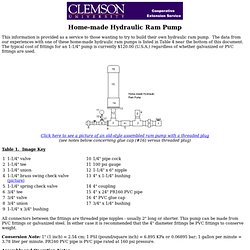
Www.builditsolar.com/Projects/Hydro/WaterTurbineAppendix.pdf. Aspen Hollow Hydro System. Intake Structure The intake is a 20' (6 m) length of 18" (45 cm) diameter pipe with hundreds of 0.5" (12 mm) holes drilled in it.
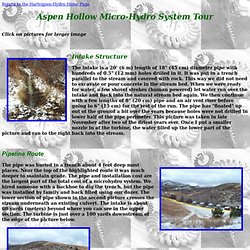
It was put in a trench parallel to the stream and covered with rock. This way we did not need to excavate or pour concrete in the stream bed. When we were ready for water, a few shovel strokes (human powered) let water run over the intake and back into the natural stream bed again. We then continue with a few lengths of 8" (20 cm) pipe and an air vent riser before going to 6" (15 cm) for the rest of the run. Pipeline Route The pipe was buried in a trench about 4 feet deep most places. Turbine Blockhouse A small shelter for the turbine and piping was build from concrete block.
Turbine and Nozzle Piping. Guide to Hydropower. Canyon Hydro has developed this Guide to Hydropower to help you gain a basic understanding of how "home power" micro-hydro systems work, and what goes into the design.
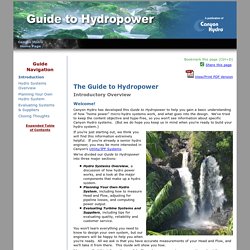
We’ve tried to keep the content objective and hype-free, so you won’t see information about specific Canyon Hydro systems. (But we do hope you keep us in mind when you’re ready to build your hydro system.) If you’re just starting out, we think you will find this information extremely helpful. Www.microhydropower.com. Getting Started. In order to calculate the amount of power available at your site, you will need the following information: Head: The vertical distance (in feet) from the water intake to the turbine.
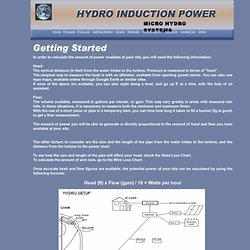
Pressure is measured in terms of "head". The simplest way to measure the head is with an altimeter, available from sporting goods stores. You can also use topo maps, available online through Google Earth or similar sites. If none of the above are available, you can also sight along a level, and go up 5' at a time, with the help of an assistant. Flow: The volume available, measured in gallons per minute, or gpm. Canyon Hydro Micro Hydroelectric Systems. Canyon Hydro designs and manufactures small hydro systems ranging from 4kW to 25MW.

Each system is designed and built at our manufacturing facilites in the USA. For our customers with residential or small community projects, Canyon Hydro provides a broad selection of micro-hydro systems up to about 100kW, each delivering high efficiency, quality and reliability at a reasonable cost. If you have requirements for larger systems, please refer to Canyon Hydro Utility/IPP Systems. This dual-jet system, located in Costa Rica, drives a 14kW generator, and uses a needle nozzle to allow adjustment for changing flow conditions without shutting the system down. Alternative & Renewable Energy - ABS Alaskan, Inc. Hydroelectric power is widely used by many major utility suppliers in the form of large hydroelectric dams.

Of course all the hydroelectric dams in the world won't help provide power to a home or village outside the reach of the electric power grid. "Micro-hydro" power is another option for gathering electric power from moving water sources. By using small water turbines fed from a river or stream, individuals can gather consistent power from the water, no matter how far from the utility power grid they may be. Microhydro Electricity Basics. What is Microhydro Power?
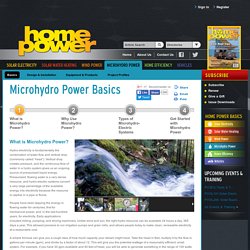
Hydro-electricity is fundamentally the combination of water flow and vertical drop (commonly called “head”). Vertical drop creates pressure, and the continuous flow of water in a hydro system gives us an ongoing source of pressurized liquid energy. Pressurized, flowing water is a very dense resource, and hydro-electric systems convert a very large percentage of the available energy into electricity because the resource is captive in a pipe or flume. People have been tapping the energy in flowing water for centuries, first for mechanical power, and, in the last hundred years, for electricity. Early applications included milling, pumping, and driving machinery. Micro Hydro Power in the Nineties. Making an Undershoot Water Wheel. Search The Renewable Energy site for Do-It-Yourselfers Some pictures of the water wheel: Note: A couple of these pictures do not appear in the "Full Details" write up above.
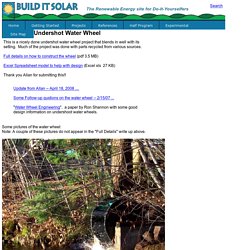
The wheel in operation. Www.builditsolar.com/Projects/Hydro/CanadaMicroHydroGuide.pdf. S Free micro-hydro calculator. Our Free Micro-Hydro Calculator Use to calculate: Power or watts your stream can produce Necessary pipe diameter for your penstock (based on Hazen-Williams pipe-friction formulas) Amount of money you'll save by generating your own electricity Number and size of nozzles Motor output (volts and either watts or amps) per RPM Which generator/turgo combo is right for your site.

APM HDRO_Home of the User-Friendly Hydro. Www.centralboiler.com/sizingchart.pdf. Outside Wood Burning Furnace - Boiler - Outdoor Wood Stove. Thermosiphon. Thermosyphon circulation in a simple solar water heater Thermosiphon (alt. thermosyphon) is a property of physics and refers to a method of passive heat exchange based on natural convection, which circulates a substance (liquid, or gas such as air) without the necessity of a mechanical pump.
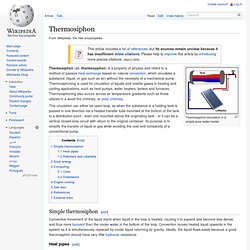
Thermosiphoning is used for circulation of liquids and volatile gases in heating and cooling applications, such as heat pumps, water heaters, boilers and furnaces. Thermosiphoning also occurs across air temperature gradients such as those utilized in a wood fire chimney, or solar chimney. This circulation can either be open-loop, as when the substance in a holding tank is passed in one direction via a heated transfer tube mounted at the bottom of the tank to a distribution point - even one mounted above the originating tank - or it can be a vertical closed-loop circuit with return to the original container.
Simple thermosiphon[edit] Heat pipes[edit] Reboilers and calandria[edit] Solar energy[edit] Central Boiler - E-Classic® Models. Living on a Dime. Making Homemade Laundry Soap. This page is my own personal writings and is copyright protected. NO PART OF THIS PAGE MAY BE COPIED AND PASTED ONTO WEBSITES, BLOGS OR MESSAGE BOARD FORUMS! Making Homemade Laundry Soap By Crystal Miller Making your own laundry soap is very easy! No longer do you need to rely on store bought detergents. ~If after reading through this you have a question PLEASE read the "Questions Answered" at the bottom of this page. What Ingredients Do You Need? You will need 3 basic ingredients; a soap of some sort, washing soda and borax.
The Soap: The most typical type of soap to use is Fels Naptha. Washing Soda: This is not to be confused with baking soda. Borax: Borax is a naturally occurring mineral: Sodium Borate. The Recipe Now that you have assembled all the needed ingredients here is the recipe: Homemade Laundry Soap 1/3 bar Fels Naptha or other type of soap, as listed above ½ cup washing soda ½ cup borax powder ~You will also need a small bucket, about 2 gallon size~ Protecting Water Supply Springs. Www.lboro.ac.uk/well/resources/technical-briefs/34-protecting-springs.pdf. Pubs.cas.psu.edu/FreePubs/pdfs/XH0024.pdf. Pond Supplies. Copper(II) sulfate. Copper(II) sulfate, also known as cupric sulfate or copper sulphate, is the chemical compound with the chemical formula CuSO4. This salt exists as a series of compounds that differ in their degree of hydration. The anhydrous form is a pale green or gray-white powder, whereas the pentahydrate (CuSO4·5H2O), the most commonly encountered salt, is bright blue.
Copper(II) sulfate exothermically dissolves in water to give the aquo complex [Cu(H2O)6]2+, which has octahedral molecular geometry and is paramagnetic. Other names for copper(II) sulfate are "blue vitriol" and "bluestone".[7] Preparation of copper(II) sulfate by electrolyzing sulfuric acid, using copper electrodes.